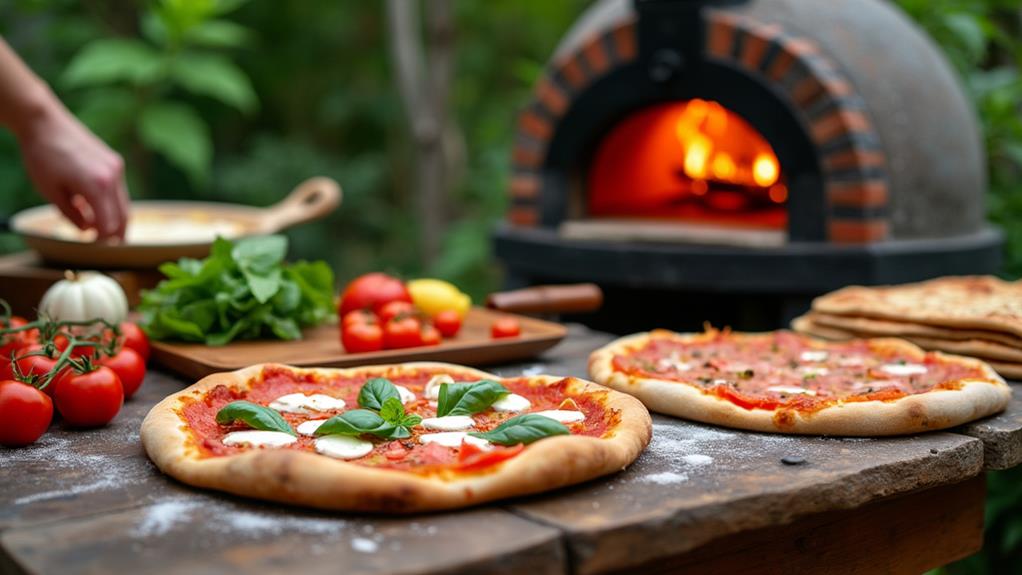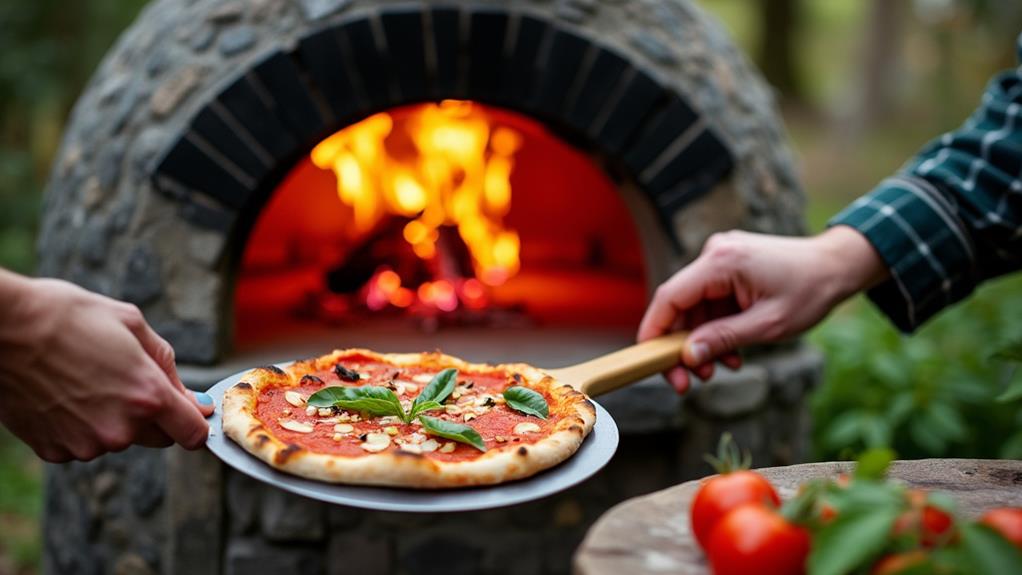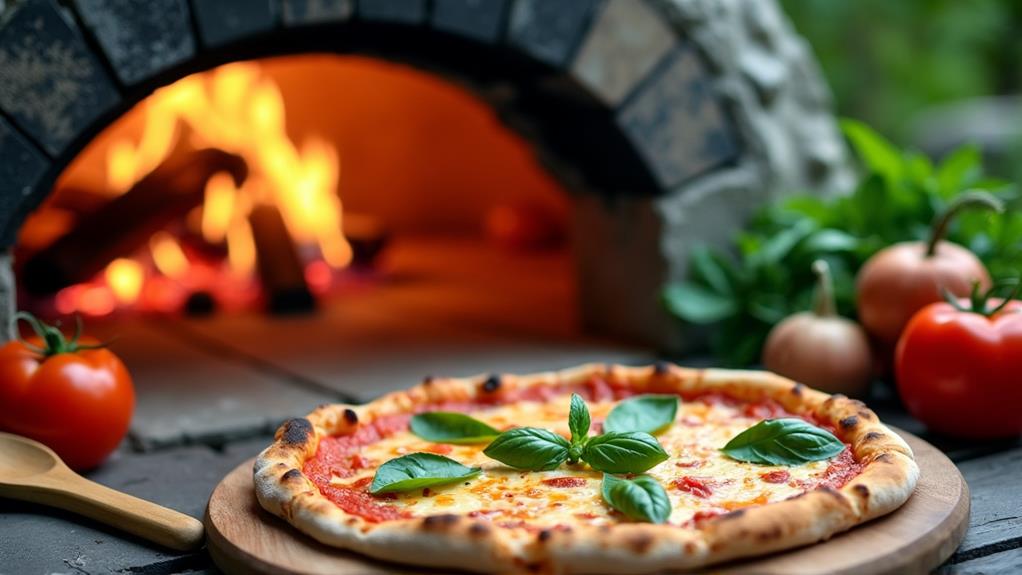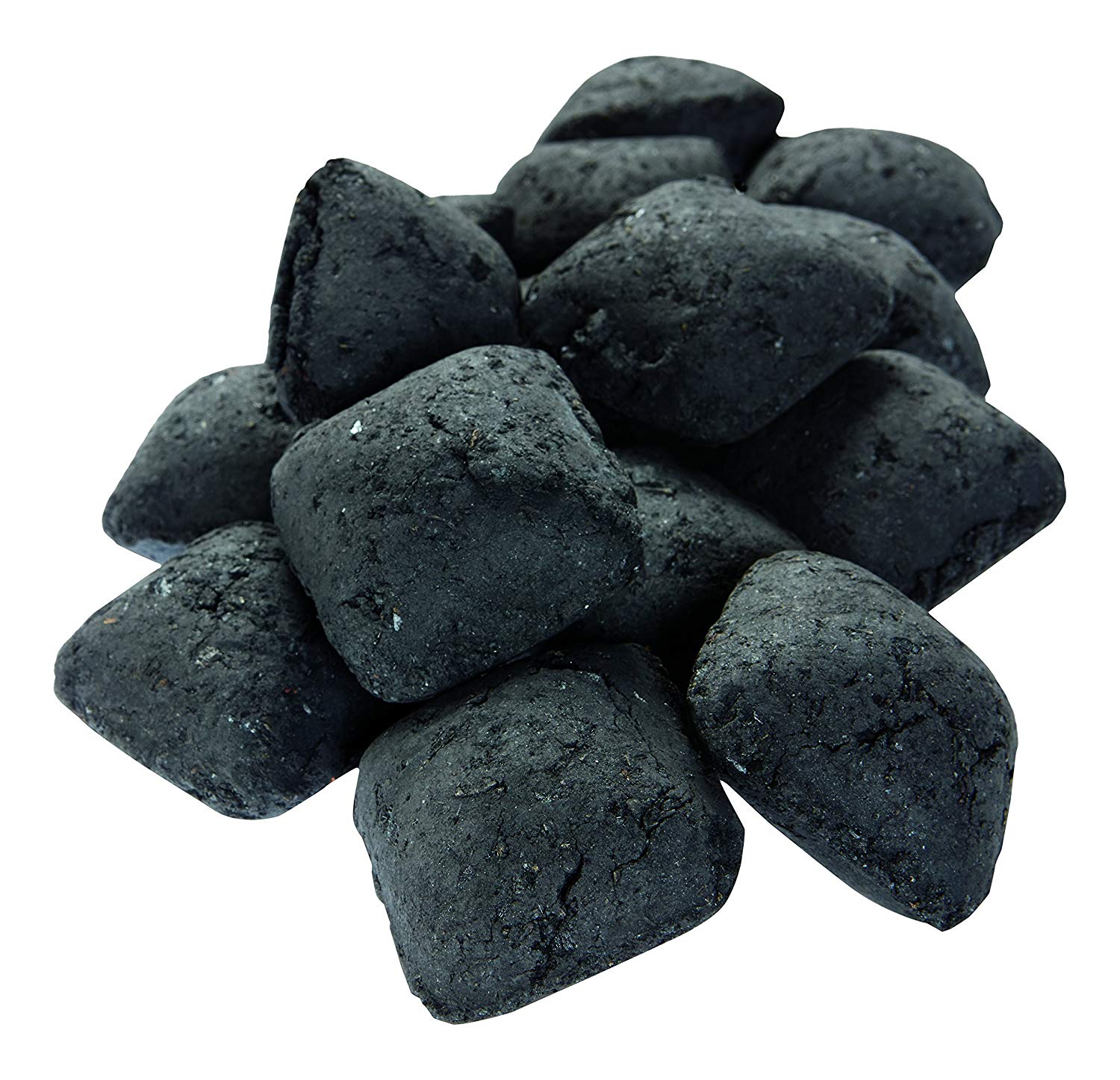Charcoal Pizza Oven Vs. Wood-Fired: Which Is Better?
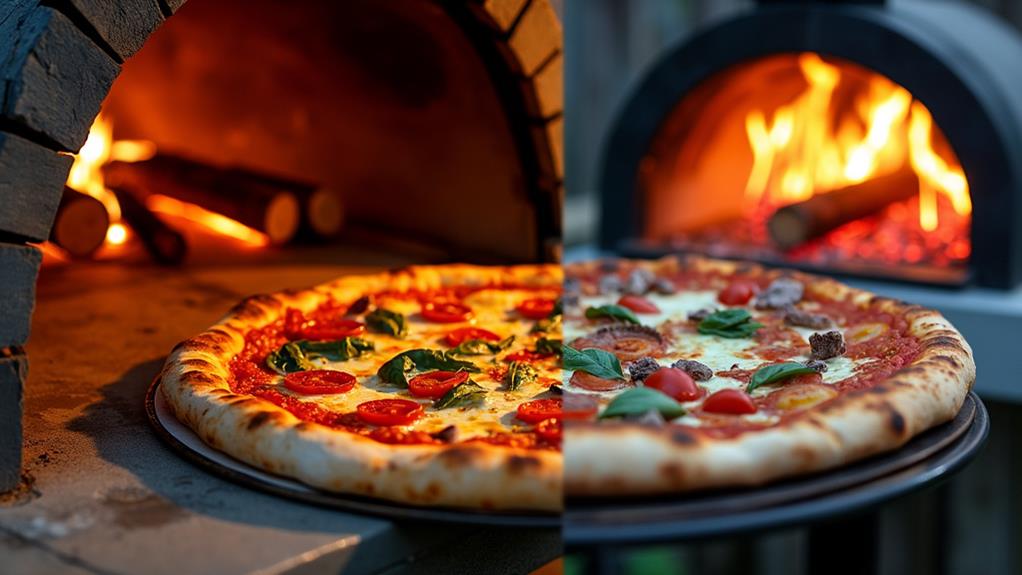
When deciding between a charcoal pizza oven and a wood-fired one, it's essential to weigh the high temperatures and crispy crusts of charcoal against the smoky flavor and softer texture wood brings.
Charcoal ovens can reach up to 1,000°F, offering a quick cook time, while wood-fired ovens operate at slightly lower temperatures but infuse richer flavors. Each method has distinct advantages, and understanding these differences can help you choose the one that best suits your culinary needs. But which option stands out in terms of cost, environmental impact, and overall experience?
Let's investigate further.
Overview of Charcoal Pizza Ovens
Charcoal pizza ovens, often called coal-fired ovens, offer a unique approach to traditional pizza making due to their high-temperature capabilities, typically reaching between 800-1,000°F.
These ovens utilize anthracite coal, known for its high carbon content and extended burn time, ensuring consistent and rapid cooking, with pizzas ready in just 2 to 3 minutes.
A standout feature of charcoal pizza ovens is the distinct crispy exterior they produce. The intense heat not only accelerates cooking but also imparts a unique charred flavor that's difficult to replicate with other cooking methods.
This results in a perfect balance between a crispy crust and a chewy interior, elevating each bite to a gourmet level.
Charcoal pizza ovens are generally larger than wood-fired ovens, allowing for the simultaneous cooking of multiple pizzas, typically ranging from 16 to 18 inches in diameter.
Mastering heat control in these ovens involves strategically layering different types of charcoal, which enhances the flavor and texture of the pizza crust.
This layering technique is crucial for achieving the distinctive taste and texture characteristic of pizzas made in charcoal ovens.
Overview of Wood-Fired Pizza Ovens
Wood-fired pizza ovens, characterized by their dome-shaped design, offer an authentic and rustic approach to pizza making.
These ovens typically operate at temperatures between 650 and 900°F, facilitating rapid cooking times of just 60 to 90 seconds per pizza. This high heat is crucial for achieving the perfect texture and flavor in your pizzas.
Using a wood-fired oven requires hardwood as fuel, ideally seasoned to achieve the right moisture content and optimal flavor. Properly seasoned wood enhances the oven's performance and imparts the unique smoky flavor that defines a true Neapolitan-style pizza.
In a wood-fired oven, pizzas are usually made smaller, around 11 to 13 inches in diameter, which is ideal for the intense heat and quick cooking times.
Managing the heat is essential; the placement of the pizza inside the oven significantly influences the final result.
Cooking Temperatures and Times
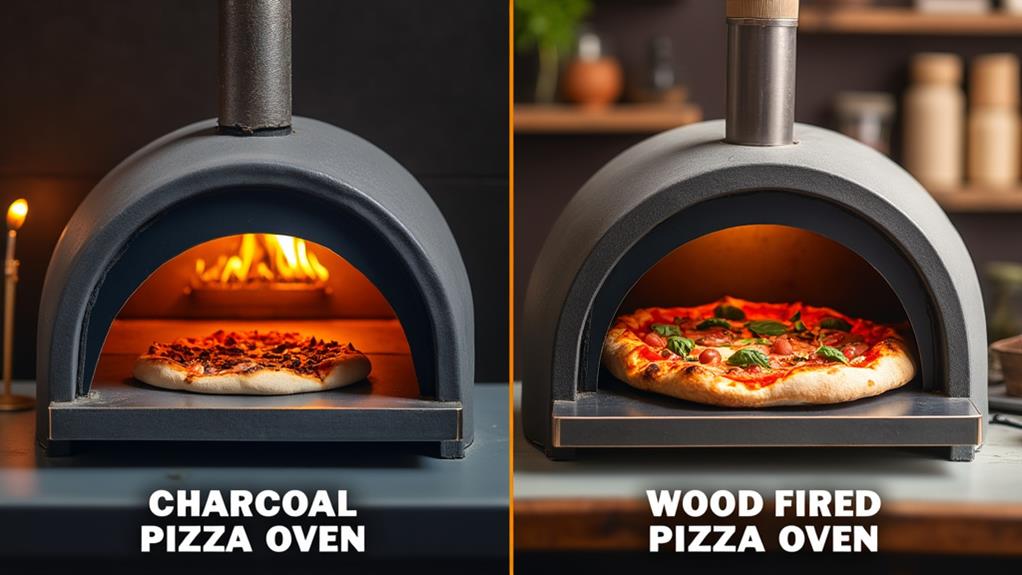
Understanding the cooking temperatures and times of different pizza ovens can greatly impact the quality of your homemade pizzas.
A charcoal pizza oven operates at scorching temperatures between 800-1000°F. This high-heat method allows you to cook a pizza in just 2 to 3 minutes. The intense heat from the charcoal, especially anthracite coal, ensures a consistent burn and results in a charred yet pliable crust, offering a unique dining experience.
In contrast, wood-fired pizza ovens cook at slightly lower temperatures, generally between 600-800°F. Despite the lower temperature, these ovens can cook your pizza swiftly, usually in 60 to 90 seconds at peak heat. The cooking method in a wood-fired oven gives your pizza a softer, more delicate texture, which many find delightful.
Both types of ovens are highly valued in the culinary world for their ability to enhance flavor and texture through their unique heat profiles.
While the charcoal oven offers a distinct charred flavor and fast cooking times, the wood-fired oven provides a softer crust and quick cooking process at peak heat. Choosing between them depends on your preferred pizza texture and flavor.
Flavor Profiles
When considering cooking temperatures and times, it's essential to understand how these factors influence the flavor profile of your pizza.
Coal-fired pizzas often boast a distinct charred flavor due to the intense heat and cooking method. This high temperature creates a crispy exterior with a robust, slightly burnt taste, which many pizza lovers find irresistible.
In contrast, wood-fired pizzas offer smoky, earthy undertones, providing a different yet equally compelling flavor experience.
Key flavor components to consider:
- Coal-Fired Pizza: These pizzas have a unique char on the crust, enhancing the overall flavor with a slightly burnt, crispy finish.
- Wood-Fired Pizza: These pizzas have a softer crust with nuanced smokiness, lending a more earthy taste.
- Texture and Flavor: The intense heat from coal ovens results in a crispier crust, whereas wood-fired methods yield a softer, more delicate center.
Ultimately, your preference may depend on whether you prefer the bold char of a coal-fired pizza or the subtle smokiness of a wood-fired one.
Both cooking methods offer distinct and delicious flavor profiles that can elevate your pizza experience.
Texture Differences
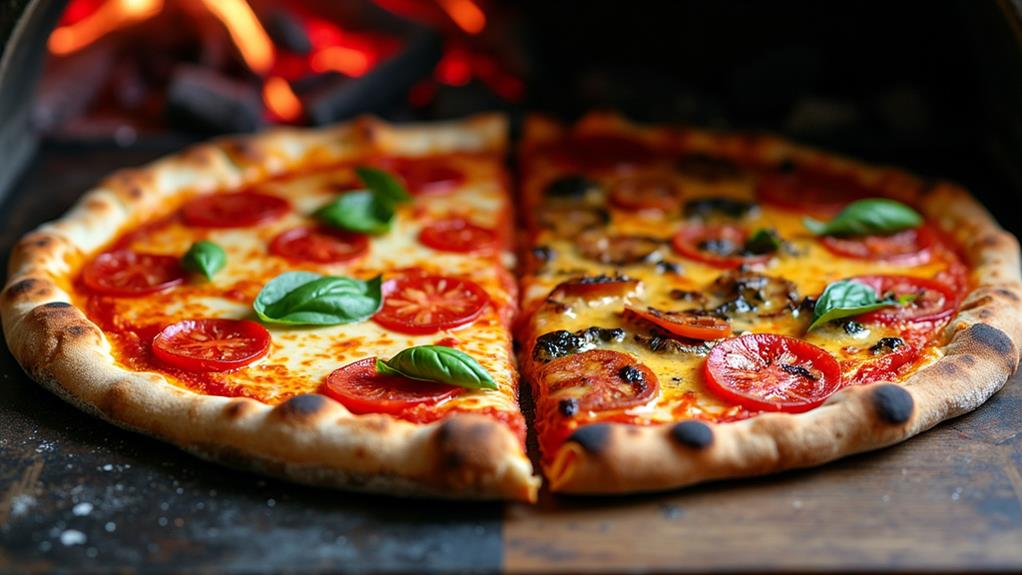
When it comes to texture, coal-fired and wood-fired pizzas each bring unique characteristics that cater to different preferences.
Coal-fired pizzas feature a crispy, thin crust with a chewy center, achieved by the high temperatures and quick cooking time on the oven floor. The blackened crusts, often mistaken for burnt, add a distinct charred flavor that enhances the overall taste experience.
In contrast, wood-fired pizzas offer a softer, more delicate texture due to the lower cooking temperature and longer cooking time. This results in a crepe-like middle, and the crust is heartier and denser compared to the pliable nature of coal-fired crusts.
These textural differences are significant, as they can greatly influence your overall enjoyment of the meal.
Fuel Types and Costs
When choosing between a charcoal pizza oven and a wood-fired one, it's essential to consider the type and cost of fuel, as well as their respective heating efficiencies.
1. Fuel Types: Charcoal ovens typically use hardwood charcoal, which is free of binders and combustibles, making it a cleaner option.
Wood-fired ovens, however, use wood splits, which can vary in quality depending on seasonal availability.
2. Fuel Costs: While fuel costs for both types of ovens are relatively similar, hardwood charcoal generally tends to be more expensive than traditional wood splits.
This cost difference might be significant if you plan to use your oven frequently.
3. Heating Efficiency: Charcoal ovens heat up quickly and are efficient for immediate cooking needs.
In contrast, wood-fired ovens require a longer initial heating time, often around 45 minutes, which can impact your cooking schedule and convenience.
Additionally, anthracite coal offers consistent performance year-round, whereas wood quality can fluctuate.
Local regulations may also influence your choice, so it's important to review these guidelines when selecting your fuel type. Balancing these factors will help you decide which oven best meets your needs.
Environmental Impact
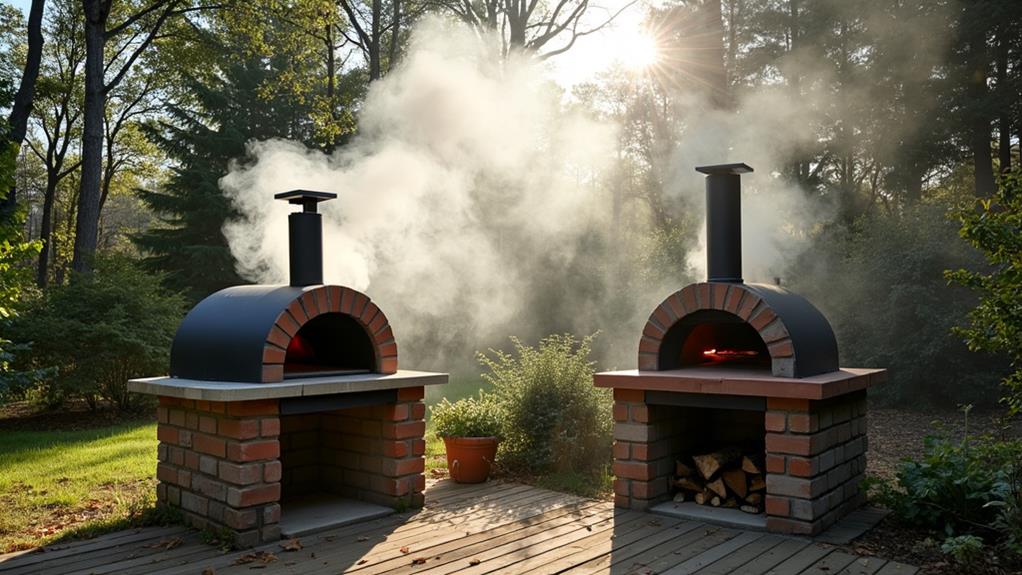
When evaluating the environmental impact of pizza ovens, it's essential to assess fuel source sustainability, emissions, and resource consumption efficiency.
Coal-fired ovens, often using anthracite coal, burn relatively cleanly but still release harmful pollutants.
Wood-fired ovens can be more sustainable if the wood is sourced responsibly, though they pose risks of deforestation and typically require longer cooking times.
Fuel Source Sustainability
Coal-fired pizza ovens, which use anthracite coal, pose significant environmental challenges due to harmful emissions such as sulfur compounds. These emissions necessitate specialized equipment to manage, complicating their sustainability efforts.
Conversely, wood-fired ovens offer a more eco-friendly alternative. Utilizing sustainably sourced hardwood contributes to a renewable and biodegradable energy source, lowering the carbon footprint compared to coal-fired ovens.
Additionally, wood-fired ovens often create a moister cooking environment, enhancing flavor without substantial environmental costs.
In summary, the sustainability factors include:
- Renewability: Wood from sustainable sources is a renewable resource, unlike anthracite coal.
- Carbon Footprint: Wood-fired ovens typically have a lower carbon footprint, making them a greener choice.
- Consumer Preference: Growing consumer demand for sustainable and eco-friendly options makes wood-fired ovens more favorable.
Emission and Air Quality
When comparing pizza ovens, one critical aspect to evaluate is their impact on emissions and air quality. Coal-fired ovens can emit harmful gases, including sulfur compounds, which significantly deteriorate air quality and contribute to pollution. The combustion of coal often results in excessive smoke and unpleasant odors, negatively affecting the surrounding environment and community health.
In contrast, wood-fired ovens generally produce fewer harmful emissions. With proper management, wood burns more cleanly than coal, resulting in a smaller environmental footprint and less impact on air quality. However, emissions can still vary depending on the type of wood used and how it's burned.
Emission regulations also play a key role. Depending on your location, stricter rules may influence whether coal or wood is a viable option for your pizza oven. Hardwood charcoal can be a more environmentally friendly alternative, reducing emissions and the carbon footprint compared to traditional coal.
| Oven Type | Emissions | Impact on Air Quality |
|---|---|---|
| Coal-fired | High sulfur compounds | Negative, increased pollution |
| Wood-fired | Lower harmful emissions | Better, cleaner combustion |
| Hardwood Charcoal | Lower emissions | Reduced carbon footprint |
Considering these factors, wood-fired ovens and hardwood charcoal tend to have a more favorable impact on air quality.
Resource Consumption Efficiency
Resource consumption efficiency significantly impacts the environmental footprint of pizza ovens. A comparison between wood-fired and coal-fired ovens highlights notable differences in resource use.
1. Fuel Efficiency: Coal-fired ovens generally operate at higher temperatures with less fuel consumption. Anthracite coal, known for its high carbon content, burns cleaner and longer than wood, thereby reducing the fuel needed per pizza.
2. Sourcing and Sustainability: Wood-fired ovens require hardwood, which must be sustainably sourced to prevent deforestation and its adverse effects on biodiversity and air quality.
Conversely, while coal can also be sourced sustainably, its extraction and transportation are resource-intensive and energy-consuming.
3. Air Quality Impact: Wood combustion produces more smoke and particulate matter compared to coal, potentially degrading local air quality.
Therefore, coal-fired ovens may be a preferable choice for those prioritizing immediate environmental impact.
This comparison underscores the importance of considering resource consumption efficiency when evaluating the environmental impact of pizza ovens.
Cultural Significance
When comparing the cultural significance of coal-fired and wood-fired pizza, their historical roots and regional popularity trends are essential.
Coal-fired pizza, stemming from the Italian immigrant experience in New York, contrasts with the traditional Neapolitan style cooked in wood-fired ovens.
This distinction underscores how authenticity and tradition shape the evolution of pizza culture in different regions.
Historical Roots Comparison
Both charcoal and wood-fired pizza ovens have deep historical roots that reflect their cultural importance. Coal ovens gained popularity in the U.S. primarily because of coal's accessibility and affordability. Italian immigrants, especially in New York, adapted traditional brick ovens for pizza cooking, thus giving rise to the iconic New York-style pizza.
In contrast, wood-fired ovens are integral to traditional Italian cooking, particularly for Neapolitan-style pizza, where wood is essential for achieving authentic flavors.
Key Historical Points:
- Coal Ovens: These ovens became popular among Italian immigrants in urban areas, contributing to the development of the Americanized version of pizza.
- Wood-Fired Ovens: Central to rustic, artisanal pizza-making traditions, these ovens are crucial for authentic Italian cuisine.
- Regional Adaptations: The use of different fuel types and cooking methods illustrates how pizza has evolved to fit various cultural and environmental contexts.
The evolution of both coal and wood-fired pizza ovens highlights the significant role of immigration in shaping American food culture.
Coal-fired pizza adapts well to urban environments, while wood-fired pizza symbolizes traditional, artisanal craftsmanship. Both methods continue to influence contemporary culinary trends.
Regional Popularity Trends
The regional popularity of coal-fired and wood-fired pizza ovens underscores their cultural significance across different areas.
Coal-fired ovens have deep roots in New York City, introduced by Italian immigrants. In regions with strong Italian-American communities, coal-fired pizza holds nostalgic appeal, considered a local staple that evokes old-world pizza traditions.
As coal-fired pizza gains traction beyond New York, establishments like Providence Coal Fired Pizza have garnered national attention, ranking 47th Best Pizza in America. This trend suggests a growing interest in gourmet pizza experiences, with coal-fired ovens becoming popular in various regions, reflecting evolving dining preferences.
Conversely, wood-fired pizza is synonymous with traditional Neapolitan cooking methods and is a highlight in many artisan Italian restaurants, emphasizing authenticity and traditional techniques.
This style of pizza holds significant cultural value within the culinary landscape. The regional popularity of coal-fired versus wood-fired pizzas illustrates evolving tastes among pizza enthusiasts.
Whether you prefer the nostalgic charm of coal-fired ovens or the authentic appeal of wood-fired, both styles offer unique cultural experiences.
Authenticity and Tradition
Regional popularity trends highlight how coal-fired and wood-fired ovens captivate pizza enthusiasts with their unique flavors and cooking techniques.
Wood-fired pizza, rooted in traditional Italian methods, especially for Neapolitan-style pizza, evokes authenticity. These ovens, with their crackling wood and high temperatures, create a delightful char and smoky flavor, embodying the essence of Italian gastronomy.
Conversely, coal-fired ovens tell a distinct yet equally compelling story. Popularized by Italian immigrants in New York City, coal-fired methods have shaped the iconic New York-style pizza, adding a modern twist to classic recipes. This evolution showcases the adaptability and creativity of immigrant communities in America.
Both wood-fired and coal-fired pizzas carry rich cultural narratives:
- Wood-Fired: Emphasizes traditional Italian cooking, offering an authentic taste of Italy.
- Coal-Fired: Represents the immigrant experience in America, particularly in NYC.
- Authenticity: Both methods reflect deep-rooted culinary practices and evolving traditions.
Whether you prefer the rustic charm of wood-fired or the unique flavor of coal-fired, each method has its own story and cultural significance.
Popularity and Availability
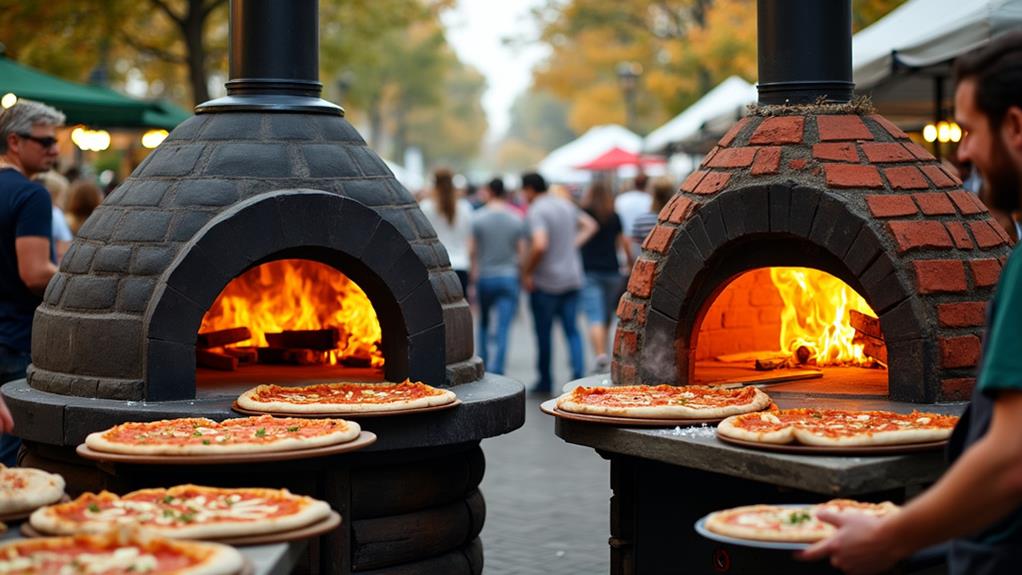
Interest in coal-fired pizza has surged, transforming it from a New York specialty into a nationwide phenomenon. This style, often called "black diamond pies," has gained significant traction across various regions. Establishments such as Providence Coal Fired Pizza are ranked among the best in the U.S., showcasing the appeal of this cooking method.
More pizzerias nationwide are adopting coal ovens to differentiate their offerings from traditional wood-fired options. Essentially, the coal oven serves both as a cooking tool and a valuable marketing asset.
While wood-fired pizza has long been a staple in artisan Italian restaurants, coal-fired pizza is carving out its niche in the gourmet market. This style attracts pizza enthusiasts who crave unique flavors and textures.
The distinct cooking methods of wood-fired and coal-fired pizzas create diverse culinary experiences. As a result, many consumers are driven to compare these styles, further enhancing interest in coal-fired options.
With coal-fired pizza becoming more accessible, you're encouraged to taste-test and discover what suits your palate. This exploration contributes to its rising popularity, making coal-fired pizza a compelling choice in today's varied pizza landscape.
Conclusion
Choosing between a charcoal pizza oven and a wood-fired one depends on your specific preferences and cooking style. If you enjoy a crispy, charred crust and don't mind a slightly longer cooking time, a charcoal oven is ideal. Conversely, if you prefer a smoky flavor with a softer crust and quicker cooking, a wood-fired oven is the way to go. Both options offer distinct benefits, so either choice will enhance your pizza-making experience. Enjoy your culinary journey!

